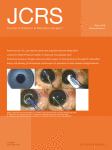
JCRS Vol 45 Issue 3 March 2019
Prediction of refractive outcomes after cataract surgery in patients who have undergone vitrectomy is challenging. US researchers evaluated outcomes in a retrospective case series review involving 61 eyes of 57 patients with a mean age of 60 years. Indications for vitrectomy included macular hole, macular pucker, vitreous haemorrhage, retinal detachment, proliferative diabetic retinopathy with vitreomacular traction and visually significant vitreous debris with bleb-associated endophthalmitis after treatment with intravitreal antibiotics. Statistically significant differences between the predicted and actual refractive outcomes were found with all of the formulas used, except the WKA Holladay and WKA SRK/T. The Holladay 2 had the highest percentage of outcomes within 0.5D of predicted, at 60.42%. Given the variability in predicting refractive outcomes, patients should be counselled accordingly, the researchers conclude.
T Lamson et al., “Refractive outcomes of phacoemulsification after pars plana vitrectomy using traditional and new intraocular lens calculation formulas”, Volume 45, Issue 3, 293-297.
Capsulorhexis comparison in white cataracts
Femtosecond laser-assisted cataract surgery (FLACS) may be the best option in white cataract cases, a prospective study suggests. The study compared conventional phaco surgery and FLACS in 132 eyes of 132 patients (66 in each group). Anterior capsule tears were significantly more common in the conventional group than the FLACS group (12.1% versus 0%). Six FLACS cases developed incomplete capsulotomies. Capsulotomy produced better circularity index and diameter stability than capsulorhexis. IOLs were better centred in the FLACS group than the conventional group. The mean ultrasound power, absolute phaco time, effective phaco time and postoperative visual acuities were similar in both groups.
Y Zhu et al., “Lens capsule-related complications of femtosecond laser-assisted capsulotomy versus manual capsulorhexis for white cataracts”, Volume 45, Issue 3, 337-342.
Microstent and cataract surgery
Implantation of a trabecular micro bypass stent in glaucoma patients undergoing cataract surgery provides substantial, durable and safe IOP reductions, a five-year prospective study concludes. The study included 65 eyes of 43 patients with open-angle glaucoma or ocular hypertension. Among eyes without additional glaucoma surgery, the mean year-five IOP decreased by 38% to 14.7mmHg ± 3.0. Some 92% of eyes had a mean year-five IOP of 18mmHg or lower and 65% had an IOP of 15mmHg or lower. Medications were reduced by 75% to 0.5 ± 0.9 medications versus 2.0 ± 1.0 preoperatively, with only 4% of eyes on three-to-four medications versus 28% preoperatively. More than two-thirds of cases were medication-free versus 5% preoperatively. Safety was favourable throughout the follow-up.
T Neuhann et al., “Long-term effectiveness and safety of trabecular micro bypass stent implantation with cataract surgery in patients with glaucoma or ocular hypertension: Five-year outcomes”, Volume 45, Issue 3, pages 312–320.

 JCRS Vol 45 Issue 3 March 2019
JCRS Vol 45 Issue 3 March 2019